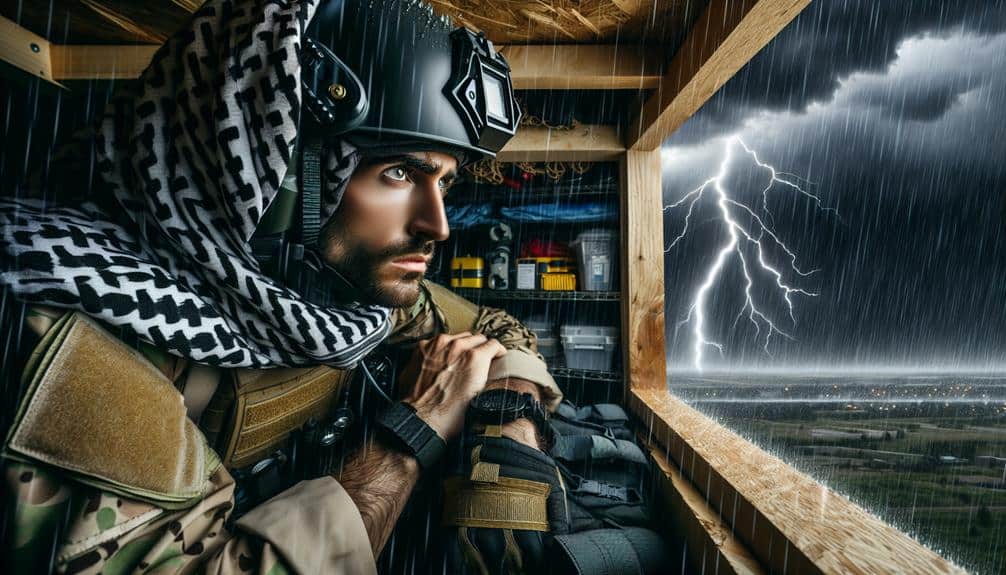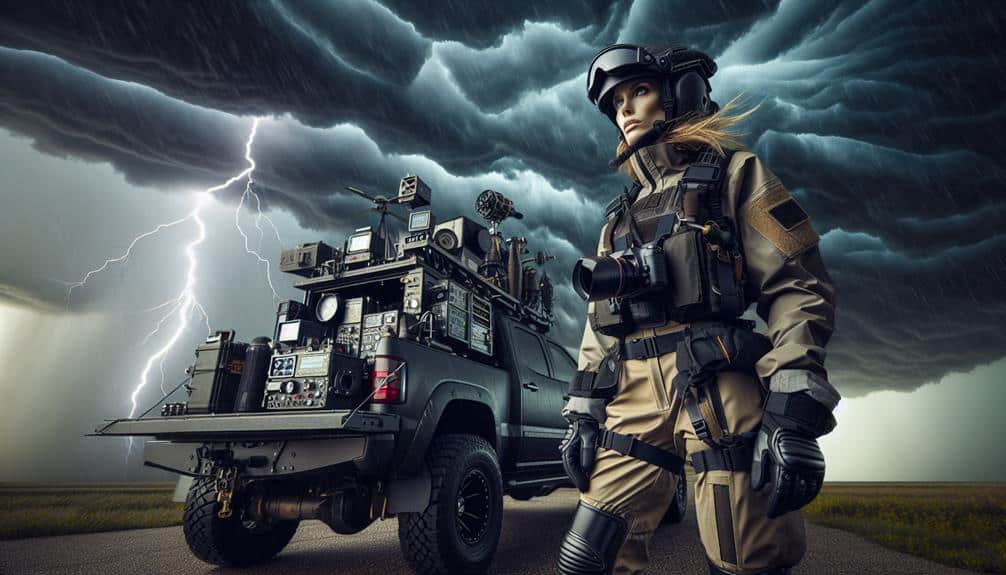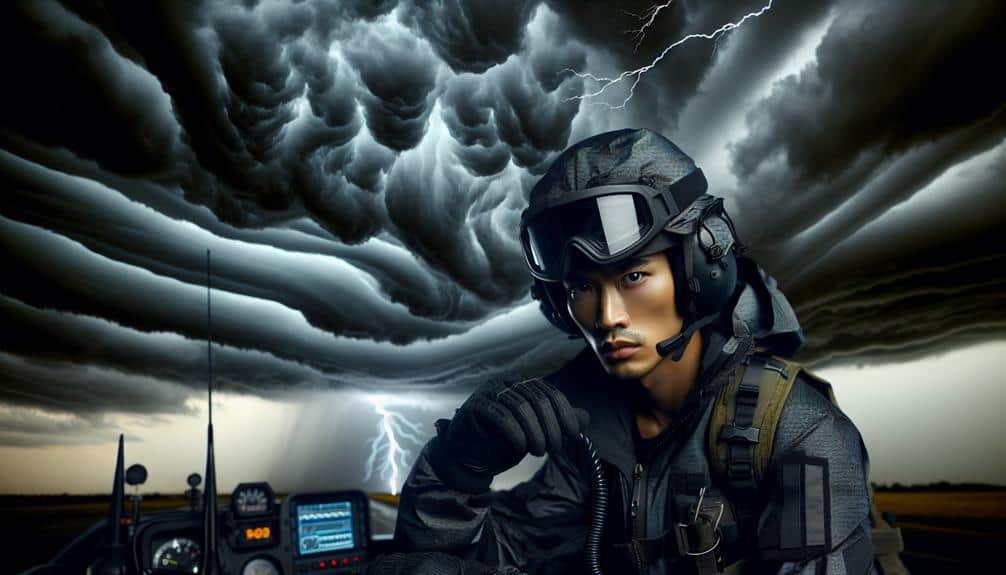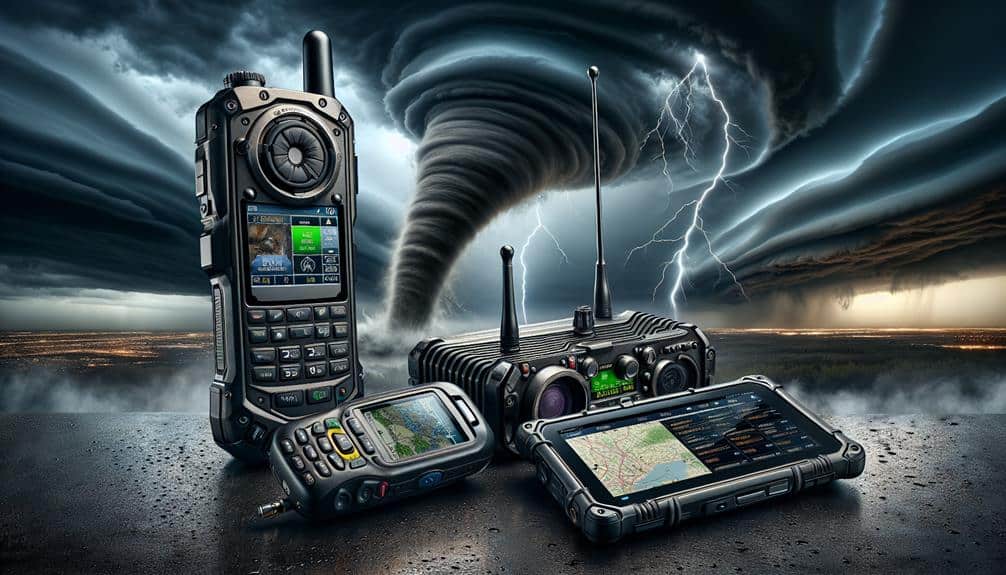As storm chasers, we prioritize all-encompassing safety gear to navigate hazardous conditions effectively. We wear robust, weather-resistant footwear and durable, moisture-wicking clothing with waterproof layers. We need high-quality protective headgear and precise weather instruments like anemometers and GPS-enabled stations for accurate data. A fully stocked first aid kit with bandages, antiseptics, and emergency tools is essential. Reliable communication devices, such as satellite phones and walkie-talkies, keep us connected, while portable emergency shelters offer rapid deployment for safety and comfort. These essentials ensure we're ready for the unpredictable, and there's more to understand about our preparation process.
Key Points
- Sturdy footwear and durable clothing for protection against harsh conditions.
- Protective headgear meeting impact resistance standards like ANSI or ASTM.
- Handheld weather monitoring equipment for real-time temperature and humidity measurements.
- Fully stocked first aid kits and advanced medical supplies for emergencies.
Sturdy Footwear
When storm chasing, we can't emphasize enough the importance of wearing durable footwear that offers both protection and traction. Footwear durability is paramount; our shoes must withstand harsh conditions and unpredictable terrains. High-quality materials like full-grain leather or synthetic composites often provide the necessary toughness. Equally important is weather resistance. Whether we encounter heavy rain or muddy paths, our footwear must keep our feet dry and maintain structural integrity.
Shoe comfort is another vital factor. Long hours on our feet are inevitable, and discomfort can lead to fatigue, reducing our ability to react swiftly. Cushioned insoles and ergonomic designs help maintain comfort over extended periods.
Moreover, advanced traction features are essential. Outsoles with deep lugs or specialized rubber compounds enhance grip, minimizing the risk of slipping on wet surfaces or loose gravel.
Durable Clothing
We need to prioritize wearing clothing made from strong materials that can withstand the harsh elements encountered during storm chasing. Durability is essential, given that we may face high winds, heavy rain, or even hail. Our clothing must offer protection without sacrificing comfort or mobility.
To achieve this balance, we should consider the following:
- Layering Options: Opt for a base layer that wicks moisture away from the skin, a mid-layer for insulation, and an outer layer that's both waterproof and windproof. This system allows us to add or remove layers based on changing weather conditions, ensuring we remain comfortable and protected.
- Durability: Choose fabrics such as ripstop nylon or reinforced polyester. These materials resist tearing and abrasion, essential when maneuvering through rough terrain or debris.
- Breathability and Insulation: Breathable fabrics like Gore-Tex help regulate body temperature and prevent overheating, while insulated layers provide warmth without bulk. This combination is vital for maintaining comfort during extended periods outdoors.
Protective Headgear
When selecting protective headgear, we must prioritize helmet material quality to guarantee maximum durability.
It's vital that the helmets meet strict impact resistance standards to protect against flying debris.
Additionally, we need to take into account comfort and fit to make sure that the headgear can be worn for extended periods without causing discomfort.
Helmet Material Quality
High-quality helmet materials are necessary for guaranteeing peak protection against the severe impacts often encountered by storm chasers. When selecting the right helmet, we need to take into account the materials used in its construction. The helmet design should incorporate advanced materials that balance weight and strength, providing both comfort and superior protection.
- Kevlar and Carbon Fiber: These materials are known for their exceptional strength-to-weight ratios, making helmets not only durable but also lightweight, which is important for prolonged use during storm chasing.
- Polycarbonate Shells: These offer a robust external layer that can absorb significant impact forces, preventing injuries from flying debris.
- Expanded Polystyrene (EPS) Foam: This material is necessary for internal padding, effectively dissipating the energy from impacts and providing cushioning for the head.
To make sure our helmets meet the highest standards, we must look for models that have undergone rigorous testing and obtained relevant safety certifications, such as ANSI, CE, or ASTM. These certifications guarantee that the helmet design has been vetted for its protective capabilities. By prioritizing superior materials and verified safety standards, we can confidently face the challenges of severe weather with the necessary protection.
Impact Resistance Standards
Verifying our helmets meet established impact resistance standards is fundamental to validating their protective capabilities against the extreme conditions faced during storm chasing. We need to prioritize helmets that have undergone rigorous impact resistance testing, guaranteeing they can withstand high-velocity debris and intense wind forces.
This testing includes simulated impacts that replicate real-world storm scenarios, providing us with confidence that our headgear will perform effectively when it matters most.
Safety certifications are a critical factor in our selection process. Helmets must comply with recognized standards such as those set by ANSI or ASTM International. These certifications signify that the helmets have met minimum safety requirements, providing us with a reliable benchmark for their protective qualities. Additionally, it's prudent to review any supplementary certifications that indicate enhanced impact resistance.
While our primary focus here is helmets, let's not overlook the importance of complementary gear like safety goggles and protective gloves. These items also need to meet stringent standards to guarantee full protection. Safety goggles should offer shatterproof lenses and a secure fit, while protective gloves must provide durability and dexterity.
Comfort and Fit
Proper comfort and fit are crucial for protective headgear to guarantee effective performance and prolonged wearability during storm chasing. When we're out in the field, comfort can't be compromised. Proper sizing and ventilation are critical components. Without correct sizing, headgear can shift or fall off, which compromises safety.
Adequate ventilation prevents overheating, allowing us to stay focused and alert.
Adjustable straps and padding play a significant role in achieving the ideal fit. Adjustable straps ensure that the headgear remains securely in place, adapting to various head shapes and sizes. Moreover, padding provides cushioning, reducing pressure points and enhancing comfort over extended periods.
When choosing protective headgear, we should focus on:
- Proper Sizing: Precise measurements guarantee a snug fit without being too tight.
- Ventilation: Sufficient airflow prevents excessive sweating and discomfort.
- Adjustable Straps and Padding: These features offer a customized fit and increased comfort.
Weather Instruments
Weather instruments are essential for storm chasers to accurately measure and monitor atmospheric conditions in real-time. Precision and reliability in our field equipment are paramount to guarantee data accuracy, which underpins our entire tracking and analysis process. High-quality anemometers, for instance, allow us to gauge wind speed with remarkable precision, while barometers provide critical pressure readings. These instruments form the backbone of our data collection efforts.
To improve tracking accuracy, we utilize advanced research technology such as GPS-enabled weather stations and mobile Doppler radar units. These tools enable us to pinpoint the location and movement of storm systems with incredible accuracy. The integration of these technologies into our field operations allows us to make real-time adjustments, enhancing both our safety and the quality of our research.
Portable weather instruments, including handheld thermometers and hygrometers, give us the flexibility to measure temperature and humidity on the go. This versatility is vital when navigating unpredictable storm environments.
First Aid Kits

When storm chasing, we must make sure our first aid kits are fully stocked with essential items and emergency medical tools. A complete kit includes bandages, antiseptics, and pain relievers, while tools like a CPR mask and a tourniquet are crucial for serious injuries.
Our preparedness can greatly impact our safety and response time in critical situations.
Essential First Aid Items
In the world of storm chasing, a meticulously stocked first aid kit is essential for addressing potential injuries and emergencies. Given the unpredictable nature of our environment, this kit becomes a cornerstone of both wilderness survival and effective emergency response.
To make sure we're prepared for a range of scenarios, our first aid kit should encompass the following essential items:
- Wound Care Supplies: These include adhesive bandages, sterile dressings, antiseptic wipes, and adhesive tape. These items help manage cuts, abrasions, and lacerations, which are common in rugged terrains.
- Pain Relief and Medications: Over-the-counter pain relievers like ibuprofen or acetaminophen, antihistamines for allergic reactions, and anti-inflammatory creams are vital. These medications address pain, inflammation, and allergic responses quickly.
- Tools and Instruments: Precision instruments such as tweezers, scissors, and a digital thermometer are necessary. They assist in removing debris from wounds, cutting dressings, and monitoring body temperature, which is crucial in diagnosing conditions like hypothermia or fever.
Emergency Medical Tools
We must equip our first aid kits with advanced emergency medical tools to handle severe injuries and important health issues that might arise during storm chasing. Given the unpredictable nature of storms, having the right gear isn't just optional—it's vital.
Our kits should include tourniquets, hemostatic dressings, and trauma shears to manage significant bleeding and injuries. A portable defibrillator can be a lifesaver in cardiac emergencies, while a set of airway management tools like nasopharyngeal and oropharyngeal airways guarantees we can maintain open airways.
Emergency medical training is essential for effectively using these important supplies. We need to understand how to administer CPR, apply a tourniquet, and use an Automated External Defibrillator (AED) under high-pressure situations. Stocking our kits with advanced supplies isn't enough; proficiency in their use saves lives.
Additionally, we must consider medication for allergic reactions, pain management, and infection prevention. Epinephrine auto-injectors, pain relievers, and antibiotics should be part of our arsenal.
Communication Devices
Effective communication devices are vital for storm chasers to relay real-time data and ensure team safety. In our high-stakes environment, reliable communication can make the difference between a successful mission and a risky situation.
Let's break down the key devices we rely on:
- Satellite Phones: These are indispensable when we're in remote areas where cellular networks fail. They provide a robust connection to emergency services and our home base, ensuring we're never out of touch.
- Walkie Talkies: These are essential for short-range communication between team members. Their simplicity and reliability make them perfect for coordinating movements and sharing immediate observations without delay.
- Mobile Data Hotspots: These allow us to access real-time weather data, maps, and other critical information online. By creating a portable Wi-Fi network, we can stay connected to forecasting tools and update our team with the latest developments.
Emergency Shelter

While robust communication keeps us informed and connected, having dependable emergency shelter secures our physical safety when weather conditions turn deadly. As storm chasers, we need to prioritize portable options that can be quickly set up.
The unpredictability of severe weather means we mightn't have much time to deploy our shelters. Portable options like pop-up tents or emergency bivvies are essential. These shelters are designed for rapid deployment, giving us the flexibility to respond swiftly to changing conditions.
For example, pop-up tents can be set up in mere seconds and provide immediate protection from wind and debris. Their compact design ensures they fit easily in our vehicles, maximizing our mobility.
Quick setup is crucial when every second counts. Shelters with automatic or manual rapid-deployment mechanisms save valuable time. Additionally, we should consider materials that can withstand harsh weather—reinforced fabrics and sturdy frames are non-negotiable.
Furthermore, having an emergency shelter with adequate ventilation and moisture resistance ensures we stay safe and relatively comfortable during prolonged storms. By integrating these elements into our storm-chasing gear, we enhance our preparedness and uphold our commitment to safety amid the freedom and thrill of the chase.
Frequently Asked Questions
Do Storm Chasers Need Special Training or Certification?
Yes, we need special training for storm chasing. Certification requirements vary, but many training programs teach meteorology, safety protocols, and emergency response. This knowledge guarantees we make informed decisions while maintaining our freedom to chase responsibly.
How Do Storm Chasers Protect Their Vehicles?
We armor our vehicles with robust modifications and protective coverings, symbolizing shields in battle. Reinforced windows, hail guards, and undercarriage protection guarantee we withstand nature's fury, allowing us to chase storms freely and safely.
What Are the Best Sources for Real-Time Weather Updates?
For real-time weather updates, we rely on weather apps and radar websites. Satellite imagery provides essential data, while social media offers immediate reports. These sources guarantee we stay informed and maintain our freedom to chase safely.
How Do You Stay Safe From Lightning Strikes While Chasing?
We prioritize lightning safety by taking specific precautions like avoiding tall structures and open fields. Our emergency response procedures include staying inside the vehicle, monitoring real-time weather updates, and having an evacuation plan ready at all times.
What Insurance Considerations Should Storm Chasers Have?
When considering insurance, we need thorough liability coverage and equipment protection. Emergency response preparations are essential, and we should guarantee weather data backups to safeguard our work. These measures maximize our safety while maintaining our operational freedom.


